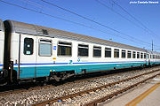
Passenger car
Encyclopedia
- This article is about railroad equipment. For other cars, see AutomobileAutomobileAn automobile, autocar, motor car or car is a wheeled motor vehicle used for transporting passengers, which also carries its own engine or motor...
and wiktionaryWiktionaryWiktionary is a multilingual, web-based project to create a free content dictionary, available in 158 languages...
definition of passenger car.
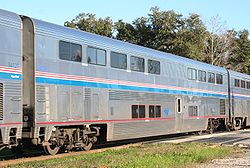

India
India , officially the Republic of India , is a country in South Asia. It is the seventh-largest country by geographical area, the second-most populous country with over 1.2 billion people, and the most populous democracy in the world...
) is a piece of railway rolling stock
Rolling stock
Rolling stock comprises all the vehicles that move on a railway. It usually includes both powered and unpowered vehicles, for example locomotives, railroad cars, coaches and wagons...
that is designed to carry passengers. The term passenger car can also be associated with a sleeping car
Sleeping car
The sleeping car or sleeper is a railway/railroad passenger car that can accommodate all its passengers in beds of one kind or another, primarily for the purpose of making nighttime travel more restful. The first such cars saw sporadic use on American railroads in the 1830s and could be configured...
, baggage
Baggage car
A baggage car or luggage van is a type of railway vehicle often forming part of the composition of passenger trains and used to carry passengers' checked baggage, as well as parcels . Being typically coupled at the front of the train behind the locomotive, this type of car is sometimes described...
, dining
Dining car
A dining car or restaurant carriage , also diner, is a railroad passenger car that serves meals in the manner of a full-service, sit-down restaurant....
and railway post office
Railway post office
In the United States a railway post office, commonly abbreviated as RPO, was a railroad car that was normally operated in passenger service as a means to sort mail en route, in order to speed delivery. The RPO was staffed by highly trained Railway Mail Service postal clerks, and was off-limits to...
cars.
19th century: First passenger cars and early development
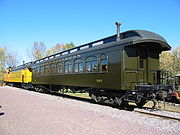
Wagon
A wagon is a heavy four-wheeled vehicle pulled by draught animals; it was formerly often called a wain, and if low and sideless may be called a dray, trolley or float....
s pulled by horse
Horse
The horse is one of two extant subspecies of Equus ferus, or the wild horse. It is a single-hooved mammal belonging to the taxonomic family Equidae. The horse has evolved over the past 45 to 55 million years from a small multi-toed creature into the large, single-toed animal of today...
s.
As railways were first constructed in England
England
England is a country that is part of the United Kingdom. It shares land borders with Scotland to the north and Wales to the west; the Irish Sea is to the north west, the Celtic Sea to the south west, with the North Sea to the east and the English Channel to the south separating it from continental...
, so too were the first passenger cars. One of the early coach designs was the "Stanhope". It featured a roof and small holes in the floor for drainage when it rained, and had separate compartments for different classes of travel. The only problem with this design is that the passengers were expected to stand for their entire trip. The first passenger cars in the United States
United States
The United States of America is a federal constitutional republic comprising fifty states and a federal district...
resembled stagecoach
Stagecoach
A stagecoach is a type of covered wagon for passengers and goods, strongly sprung and drawn by four horses, usually four-in-hand. Widely used before the introduction of railway transport, it made regular trips between stages or stations, which were places of rest provided for stagecoach travelers...
es. They were short, often less than 10 ft (3 m) long and had two axles.
British
United Kingdom
The United Kingdom of Great Britain and Northern IrelandIn the United Kingdom and Dependencies, other languages have been officially recognised as legitimate autochthonous languages under the European Charter for Regional or Minority Languages...
railways had a little bit of a head start
Head start (positioning)
In positioning, a head start is a start in advance of the starting position of others in competition, or simply toward the finish line or desired outcome...
on American railroads, with the first "bed-carriage" (an early sleeping car
Sleeping car
The sleeping car or sleeper is a railway/railroad passenger car that can accommodate all its passengers in beds of one kind or another, primarily for the purpose of making nighttime travel more restful. The first such cars saw sporadic use on American railroads in the 1830s and could be configured...
) being built there as early as 1838 for use on the London and Birmingham Railway
London and Birmingham Railway
The London and Birmingham Railway was an early railway company in the United Kingdom from 1833 to 1846, when it became part of the London and North Western Railway ....
and the Grand Junction Railway
Grand Junction Railway
The Grand Junction Railway was an early railway company in the United Kingdom, which existed between 1833 and 1846 when it was merged into the London and North Western Railway...
. Britain's early sleepers, when made up for sleeping, extended the foot of the bed into a boot section at the end of the carriage. The cars were still too short to allow more than two or three beds to be positioned end to end.
Britain's Royal Mail
Royal Mail
Royal Mail is the government-owned postal service in the United Kingdom. Royal Mail Holdings plc owns Royal Mail Group Limited, which in turn operates the brands Royal Mail and Parcelforce Worldwide...
commissioned and built the first Travelling Post Office cars in the late 1840s as well. These cars resembled coaches in their short wheelbase and exterior design, but were equipped with nets on the sides of the cars to catch mail bags while the train was in motion. American RPOs
Railway post office
In the United States a railway post office, commonly abbreviated as RPO, was a railroad car that was normally operated in passenger service as a means to sort mail en route, in order to speed delivery. The RPO was staffed by highly trained Railway Mail Service postal clerks, and was off-limits to...
, first appearing in the 1860s, also featured equipment to catch mail bags at speed, but the American design more closely resembled a large hook that would catch the mailbag in its crook. When not in use, the hook would swivel down against the side of the car to prevent it from catching obstacles.
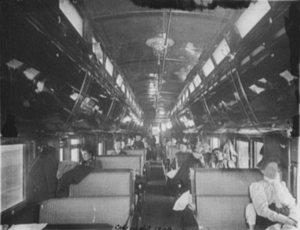
Bogie
A bogie is a wheeled wagon or trolley. In mechanics terms, a bogie is a chassis or framework carrying wheels, attached to a vehicle. It can be fixed in place, as on a cargo truck, mounted on a swivel, as on a railway carriage/car or locomotive, or sprung as in the suspension of a caterpillar...
(one at each end), and wider as their suspensions improved. Cars built for European use featured side door compartments, while American car design favored what was called a "coach", a single long cabin with rows of seats, with doors located at the ends of the car. Early American sleeping cars were not compartmented, but by the end of the 19th century they were. The compartments in the later sleepers were accessed from a side hall running the length of the cars, similar to the design of European cars well into the 20th century.
Many American passenger trains, particularly the long distance ones, included a car at the end of the train called an observation car. Until about the 1930s, these had an open-air platform at the rear, the "observation platform". These evolved into the closed end car, usually with a rounded end which was still called an "observation car". The interiors of observation cars varied. Many had special chairs and tables.
The end platforms of all passenger cars changed around the turn of the 20th century. Older cars had open platforms between cars. Passengers would enter and leave a car through a door at the end of the car which led to a narrow platform. Steps on either side of the platform were used for getting on or off the train, and one might hop from one car platform to another. Later cars had enclosed platforms called vestibules
Vestibuled train
A vestibuled train is a passenger train whose cars have enclosed vestibules at their ends, in contrast to the open platforms on early cars. Typically, a vestibule has doorways on either side to allow passenger egress at stations, a door into the body of the car, and, at the end of the car, a...
which together with gangway connections allowed passengers not only to enter and exit the train protected from the elements, but also to move more easily between cars with the same protection.
Dining cars first appeared in the late 1870s and into the 1880s. Until this time, the common practice was to stop for meals at restaurants along the way (which led to the rise of Fred Harvey's chain of Harvey House
Fred Harvey Company
The origin of the Fred Harvey Company can be traced to the 1875 opening of two railroad eating houses located at Wallace, Kansas and Hugo, Colorado on the Kansas Pacific Railway. These cafés were opened by Fred Harvey, then a freight agent for the Chicago, Burlington and Quincy Railroad...
restaurants in America). At first, the dining car was simply a place to serve meals that were picked up en route, but they soon evolved to include galleys in which the meals were prepared. The introduction of vestibuled cars
Vestibuled train
A vestibuled train is a passenger train whose cars have enclosed vestibules at their ends, in contrast to the open platforms on early cars. Typically, a vestibule has doorways on either side to allow passenger egress at stations, a door into the body of the car, and, at the end of the car, a...
, which for the first time allowed easy movement from car to car, aided the adoption of dining cars, lounge cars, and other specialized cars.
1900-1950: Lighter materials, new car types
By the 1920s, passenger cars on the larger standard gaugeStandard gauge
The standard gauge is a widely-used track gauge . Approximately 60% of the world's existing railway lines are built to this gauge...
railroads were normally between 60 ft (18.3 m) and 70 ft (21.3 m) long. The cars of this time were still quite ornate, many of them being built by experienced coach makers and skilled carpenters.
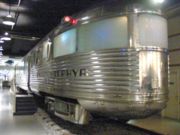
Stainless steel
In metallurgy, stainless steel, also known as inox steel or inox from French "inoxydable", is defined as a steel alloy with a minimum of 10.5 or 11% chromium content by mass....
for carbodies. The typical passenger car was now much lighter than its "heavyweight" wood cousins of old. The new "lightweight" and streamlined
Streamliner
A streamliner is a vehicle incorporating streamlining in a shape providing reduced air resistance. The term is applied to high-speed railway trainsets of the 1930s to 1950s, and to their successor "bullet trains". Less commonly, the term is applied to fully faired recumbent bicycles...
cars carried passengers in speed and comfort to an extent that had not been experienced to date. Aluminum and Cor-Ten steel were also used in lightweight car construction, but stainless steel was the preferred material for carbodies. It isn't the lightest of materials, nor is it the least expensive, but stainless steel cars could be, and often were, left unpainted except for the car's reporting mark
Reporting mark
A reporting mark is a two-, three-, or four-letter alphabetic code used to identify owners or lessees of rolling stock and other equipment used on the North American railroad network. The marks are stenciled on each piece of equipment, along with a one-to-six-digit number, which together uniquely...
s that were required by law.
By the end of the 1930s, railroads and carbuilders were debuting carbody and interior styles that could only be dreamed of before. In 1937, the Pullman Company delivered the first cars equipped with roomette
Roomette
A roomette is a type of sleeping car compartment in a railroad passenger train. The term was first used in North America, and was carried over into Australia and New Zealand...
s – that is, the car's interior was sectioned off into compartments, much like the coaches that were still in widespread use across Europe. Pullman's roomettes, however, were designed with the single traveler in mind. The roomette featured a large picture window, a privacy door, a single fold-away bed, a sink and small toilet. The roomette's floor space was barely larger than the space taken up by the bed, but it allowed the traveler to ride in luxury compared to the multilevel semiprivate berths of old.
Now that passenger cars were lighter, they were able to carry heavier loads, but the size of the average passenger that rode in them didn't increase to match the cars' new capacities. The average passenger car couldn't get any wider or longer due to side clearances along the railroad lines, but they generally could get taller because they were still lower than many freight cars and locomotives. So the railroads soon began building and buying dome
Dome car
A dome car is a type of railway passenger car that has a glass dome on the top of the car where passengers can ride and see in all directions around the train. It also can include features of a coach, lounge car, dining car or observation...
and bilevel cars to carry more passengers.
1950-present: High-technology advancements
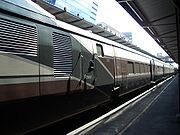
Amtrak
The National Railroad Passenger Corporation, doing business as Amtrak , is a government-owned corporation that was organized on May 1, 1971, to provide intercity passenger train service in the United States. "Amtrak" is a portmanteau of the words "America" and "track". It is headquartered at Union...
in 1971. Amtrak
Amtrak
The National Railroad Passenger Corporation, doing business as Amtrak , is a government-owned corporation that was organized on May 1, 1971, to provide intercity passenger train service in the United States. "Amtrak" is a portmanteau of the words "America" and "track". It is headquartered at Union...
took over equipment and stations from most the railroads in the U.S. with intercity service.
The higher clearances in North America enabled a major advancement in passenger car design, bi-level (double-decker) commuter coaches that could hold more passengers. These cars started to become common in the United States in the 1960s, and were adopted by Amtrak
Amtrak
The National Railroad Passenger Corporation, doing business as Amtrak , is a government-owned corporation that was organized on May 1, 1971, to provide intercity passenger train service in the United States. "Amtrak" is a portmanteau of the words "America" and "track". It is headquartered at Union...
for the Superliner
Superliner (railcar)
The Superliner is a double decker passenger car used by Amtrak on long haul trains that do not use the Northeast Corridor. The initial cars were built by Pullman-Standard in the late 1970s and a second order was built in the mid 1990s by Bombardier Transportation...
design as well as by many other railroads and manufacturers. By the year 2000 double-deckers rivaled single level cars in use around the world.
While intercity passenger rail travel declined in America, ridership continued to increase in other parts of the world. With the increase came an increased use of newer technology on existing and new equipment. The Spanish
Spain
Spain , officially the Kingdom of Spain languages]] under the European Charter for Regional or Minority Languages. In each of these, Spain's official name is as follows:;;;;;;), is a country and member state of the European Union located in southwestern Europe on the Iberian Peninsula...
company Talgo
Talgo
Talgo is a Spanish manufacturer of railway vehicles. It is best known for a design of articulated railway passenger cars in which the wheels are mounted in pairs, but not joined by an axle, and being between rather than underneath the individual coaches...
began experimenting in the 1940s with technology that would enable the axles to steer into a curve, allowing the train to move around the curve at a higher speed. The steering axles evolved into mechanisms that would also tilt the passenger car as it entered a curve to counter the centrifugal force
Centrifugal force
Centrifugal force can generally be any force directed outward relative to some origin. More particularly, in classical mechanics, the centrifugal force is an outward force which arises when describing the motion of objects in a rotating reference frame...
experienced by the train, further increasing speeds on existing track. Today, Talgo trains are used in many places in Europe and they have also found a home in North America on some short and medium distance routes such as Eugene, Oregon
Eugene, Oregon
Eugene is the second largest city in the U.S. state of Oregon and the seat of Lane County. It is located at the south end of the Willamette Valley, at the confluence of the McKenzie and Willamette rivers, about east of the Oregon Coast.As of the 2010 U.S...
, to Vancouver, British Columbia.
Another type of tilting train
Tilting train
A tilting train is a train that has a mechanism enabling increased speed on regular rail tracks. As a train rounds a curve at speed, objects inside the train experience centrifugal force. This can cause packages to slide about or seated passengers to feel squashed by the outboard armrest due to...
that is seeing widespread use across Europe
Europe
Europe is, by convention, one of the world's seven continents. Comprising the westernmost peninsula of Eurasia, Europe is generally 'divided' from Asia to its east by the watershed divides of the Ural and Caucasus Mountains, the Ural River, the Caspian and Black Seas, and the waterways connecting...
is the Pendolino
Pendolino
Pendolino is an Italian family of tilting trains used in Italy, Spain, Portugal, Slovenia, Finland, Russian Federation, the Czech Republic, the United Kingdom, Slovakia, Switzerland, China and shortly in Romania and Poland...
. These trains, built by Fiat Ferroviaria
Fiat Ferroviaria
thumb|300px|[[FS Class E626]] locomotive, a mainstay of Italian railways starting from the 1930s.Fiat Ferroviaria was the rail division of FIAT of Italy....
(now owned by Alstom
Alstom
Alstom is a large multinational conglomerate which holds interests in the power generation and transport markets. According to the company website, in the years 2010-2011 Alstom had annual sales of over €20.9 billion, and employed more than 85,000 people in 70 countries. Alstom's headquarters are...
), are in regular service in Italy
Italy
Italy , officially the Italian Republic languages]] under the European Charter for Regional or Minority Languages. In each of these, Italy's official name is as follows:;;;;;;;;), is a unitary parliamentary republic in South-Central Europe. To the north it borders France, Switzerland, Austria and...
, Portugal
Portugal
Portugal , officially the Portuguese Republic is a country situated in southwestern Europe on the Iberian Peninsula. Portugal is the westernmost country of Europe, and is bordered by the Atlantic Ocean to the West and South and by Spain to the North and East. The Atlantic archipelagos of the...
, Slovenia
Slovenia
Slovenia , officially the Republic of Slovenia , is a country in Central and Southeastern Europe touching the Alps and bordering the Mediterranean. Slovenia borders Italy to the west, Croatia to the south and east, Hungary to the northeast, and Austria to the north, and also has a small portion of...
, Finland
Finland
Finland , officially the Republic of Finland, is a Nordic country situated in the Fennoscandian region of Northern Europe. It is bordered by Sweden in the west, Norway in the north and Russia in the east, while Estonia lies to its south across the Gulf of Finland.Around 5.4 million people reside...
, Czech Republic
Czech Republic
The Czech Republic is a landlocked country in Central Europe. The country is bordered by Poland to the northeast, Slovakia to the east, Austria to the south, and Germany to the west and northwest....
and now the United Kingdom
United Kingdom
The United Kingdom of Great Britain and Northern IrelandIn the United Kingdom and Dependencies, other languages have been officially recognised as legitimate autochthonous languages under the European Charter for Regional or Minority Languages...
. Using tilting trains, railroads are able to run passenger trains over the same tracks
Rail tracks
The track on a railway or railroad, also known as the permanent way, is the structure consisting of the rails, fasteners, sleepers and ballast , plus the underlying subgrade...
at higher speeds than would otherwise be possible.
Amtrak
Amtrak
The National Railroad Passenger Corporation, doing business as Amtrak , is a government-owned corporation that was organized on May 1, 1971, to provide intercity passenger train service in the United States. "Amtrak" is a portmanteau of the words "America" and "track". It is headquartered at Union...
continued to push the development of U.S.-designed passenger equipment even when the market demand didn't support it, ordering a number of new passenger locomotive and car types in the 1980s and 1990s. However, by the year 2000 Amtrak went to European manufacturers for the Amtrak Cascades
Amtrak Cascades
The Amtrak Cascades is a passenger train route operated by Amtrak in partnership with the states of Washington and Oregon in the Pacific Northwest of the United States and the province of British Columbia in Canada...
(Talgo
Talgo
Talgo is a Spanish manufacturer of railway vehicles. It is best known for a design of articulated railway passenger cars in which the wheels are mounted in pairs, but not joined by an axle, and being between rather than underneath the individual coaches...
) and Acela Express
Acela Express
The Acela Express is Amtrak's high-speed rail service along the Northeast Corridor in the Northeast United States between Washington, D.C., and Boston via Baltimore, Philadelphia, and New York...
trains, their premier services. These trains use new designs and are made to operate as coherent "trainsets".
High-speed trains are made up of cars from a single manufacturer and usually of a uniform design (although the dining car
Dining car
A dining car or restaurant carriage , also diner, is a railroad passenger car that serves meals in the manner of a full-service, sit-down restaurant....
on the ICE
InterCityExpress
The Intercity-Express or ICE is a system of high-speed trains predominantly running in Germany and neighbouring countries. It is the highest service category offered by DB Fernverkehr and is the flagship of Deutsche Bahn...
has a dome). In the 1960s and 1970s countries around the world started to develop trains capable of traveling in the 150-200 mph range, to rival air travel. One of the first was France
France
The French Republic , The French Republic , The French Republic , (commonly known as France , is a unitary semi-presidential republic in Western Europe with several overseas territories and islands located on other continents and in the Indian, Pacific, and Atlantic oceans. Metropolitan France...
's TGV
TGV
The TGV is France's high-speed rail service, currently operated by SNCF Voyages, the long-distance rail branch of SNCF, the French national rail operator....
which entered service in 1981. By the year 2000, Western Europe's major cities (London
London
London is the capital city of :England and the :United Kingdom, the largest metropolitan area in the United Kingdom, and the largest urban zone in the European Union by most measures. Located on the River Thames, London has been a major settlement for two millennia, its history going back to its...
, Paris
Paris
Paris is the capital and largest city in France, situated on the river Seine, in northern France, at the heart of the Île-de-France region...
, Brussels
Brussels
Brussels , officially the Brussels Region or Brussels-Capital Region , is the capital of Belgium and the de facto capital of the European Union...
, Amsterdam
Amsterdam
Amsterdam is the largest city and the capital of the Netherlands. The current position of Amsterdam as capital city of the Kingdom of the Netherlands is governed by the constitution of August 24, 1815 and its successors. Amsterdam has a population of 783,364 within city limits, an urban population...
, Geneva
Geneva
Geneva In the national languages of Switzerland the city is known as Genf , Ginevra and Genevra is the second-most-populous city in Switzerland and is the most populous city of Romandie, the French-speaking part of Switzerland...
, Berlin
Berlin
Berlin is the capital city of Germany and is one of the 16 states of Germany. With a population of 3.45 million people, Berlin is Germany's largest city. It is the second most populous city proper and the seventh most populous urban area in the European Union...
, Rome
Rome
Rome is the capital of Italy and the country's largest and most populated city and comune, with over 2.7 million residents in . The city is located in the central-western portion of the Italian Peninsula, on the Tiber River within the Lazio region of Italy.Rome's history spans two and a half...
, etc.) were connected by high-speed rail service.
Often tilting and high-speed cars are left in "trainsets" throughout their service. For example, articulated car
Articulated car
Articulated cars are rail vehicles which are consist of a number of smaller, lighter cars which are semi-permanently attached to each other and which share common trucks. They are much longer than single passenger cars, and on the TGV Réseau, for example, 8 cars are joined this way...
s cannot be uncoupled without special equipment because the individual cars share trucks. This gives modern trains a smooth, coherent appearance because all the cars and often the engines share a similar design and paint scheme.
Heavyweight vs. lightweight
A heavyweight car is one that is physically heavier than a lightweight car due to its construction. While early cars used wood construction, Pullman switched to heavyweight riveted steel construction in 1910, more or less at the same time as other rail car manufacturers. Heavyweights are said to offer a more luxurious ride due to their added mass (from the plate steel construction and concrete floor) and, usually, six-wheeled trucks (bogies). The stepped roof line of early heavyweights usually consisted of a center sill section (the clerestory) that ran the length of the car and extended above the roof sides by as much as a foot. This section of the roof usually had windows or shutters that could be opened for ventilation while the train was in motion. However, railroad crews and passengers quickly discovered that when these windows were opened on a passenger train pulled by one or more steam locomotiveSteam locomotive
A steam locomotive is a railway locomotive that produces its power through a steam engine. These locomotives are fueled by burning some combustible material, usually coal, wood or oil, to produce steam in a boiler, which drives the steam engine...
s, smoke and soot from the locomotives tended to drift in through the windows, especially when the train went through a tunnel.
In the early 20th century, air conditioning was added to heavyweight cars for the first time. An air conditioned heavyweight car could be spotted easily since the area where the roof vent windows existed was now covered, either partially or in full, by the AC duct. As lightweight cars were introduced, many heavyweight cars were repurposed into maintenance of way service by the railroads that owned them.
Lightweight passenger cars required developments in steel processing that weren't available until the 1920s and 1930s. By building passenger cars out of steel instead of wood, the manufacturers were able to build lighter weight cars with smooth or fluted sides and smooth roof lines.
Steel cars were ushered in at the beginning of the streamline era of the 1930s (although not all lightweight cars were streamlined) and steel has continued in use ever since then. With the use of steel for the car sides, railroads were able to offer more innovative passenger car types. It wasn't until after the first lightweight cars were introduced that railroads began building and using dome cars because the sides of heavyweight cars weren't strong enough to support the weight of the dome and its passengers. Lightweight cars also enabled the railroads to operate longer passenger trains; the reduced car weight meant that more passengers could be carried in a greater number of cars with the same locomotives. The cost savings in hauling capacity coupled with the increased car type options led to the quick replacement of heavyweight cars with lightweight cars.
Car types
Traditionally the passenger car can be split into a number of distinct types.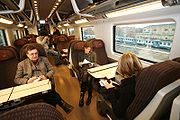
Consist
A consist , in North American railway terminology, is used as a noun to describe the group of rail vehicles that make up a train. A near-equivalent UK term is rake but this excludes the locomotive....
, hence the name.
Some specialized types are variants of or combine elements of the most basic types.
Also the basic design of passenger cars is evolving, with articulated units that have shared trucks, with double-decker designs, and with the "low floor" design where the loading area is very close to the ground and slung between the trucks.
Coach
The coach is the most basic type of passenger car, also sometimes referred to as 'chair cars'.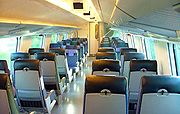
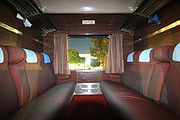
In both arrangements carry-on baggage is stowed on a shelf above the passenger seating area. The opening into the cars is usually located at both ends of the carriage, often into a small hallway - which in railway parlance is termed a vestibule
Vestibule (architecture)
A vestibule is a lobby, entrance hall, or passage between the entrance and the interior of a building.The same term can apply to structures in modern or ancient roman architecture. In modern architecture vestibule typically refers to a small room or hall between an entrance and the interior of...
.
In India normal carriages often have double height seating, with benches (berths), so that people can sit above one another (not unlike a bunk bed), in other countries true double decker carriages are becoming more common.
The seats in most coaches until the middle of the 20th century, were usually bench seats; the backs of these seats could be adjusted, often with one hand, to face in either direction so the car would not have to be turned for a return trip. The conductor would simply walk down the aisle in the car, reversing the seat backs to prepare for the return trip. This arrangement is still used in some modern trains.
Dining car
A dining car (or diner) is used to serve meals to the passengers. Its interior is split with a portion of the interior partitioned off for a galleyGalley (kitchen)
The galley is the compartment of a ship, train or aircraft where food is cooked and prepared. It can also refer to a land based kitchen on a naval base or a particular formed household kitchen.-Ship's kitchen:...
, which is off-limits to passengers. A narrow hallway is left between the galley and one side wall of the car for passengers to use. The remainder of the interior is laid out with tables and chairs to look like a long, narrow restaurant
Restaurant
A restaurant is an establishment which prepares and serves food and drink to customers in return for money. Meals are generally served and eaten on premises, but many restaurants also offer take-out and food delivery services...
dining room. There is special personnel to perform waitstaff and kitchen duties.
Lounge

These cars are often pulled in addition to the dining car
Dining car
A dining car or restaurant carriage , also diner, is a railroad passenger car that serves meals in the manner of a full-service, sit-down restaurant....
, and on very long trains in addition to one or more snack or cafe cars.
Lounge cars are an important part of the appeal of passenger trains when compared to aircraft, buses and cars; there is more space to move around, socialize, eat and drink, and a good view.
Observation

The observation car almost always operated as the last car in a passenger train. Its interior could include features of a coach, lounge, diner, or sleeper. The main spotting feature was at the tail end of the car - the walls of the car usually were curved together to form a large U shape, and larger windows were installed all around the end of the car. Before these cars were built with steel walls, the observation end of heavyweight cars resembled a roofed porch area; larger windows were installed at the observation end on these cars as well. At this end of the car, there was almost always a lounge where passengers could enjoy the view as they watch the track rapidly recede into the distance.
Sleeping car
Often called "sleepers" or "Pullman cars" (after the main American operator), these cars provide sleeping arrangements for passengers travelling at night. Early models were divided into sections, where coach seating converted at night into semi-private berths. More modern interiors are normally partitioned into separate bedroom compartments for passengers. The beds are designed in such a way that they either roll or fold out of the way or convert into seats for daytime use. Compartments vary in size; some are only large enough for a bed, while others resemble efficiency apartments including bathrooms.Baggage car

- Main articles: Baggage carBaggage carA baggage car or luggage van is a type of railway vehicle often forming part of the composition of passenger trains and used to carry passengers' checked baggage, as well as parcels . Being typically coupled at the front of the train behind the locomotive, this type of car is sometimes described...
(US) and Brake vanBrake vanBrake van and guard's van are terms used mainly in the UK, Australia and India for a railway vehicle equipped with a hand brake which can be applied by the guard...
(UK)
Although passengers generally were not allowed access to the baggage car, they were included in a great number of passenger trains as regular equipment. The baggage car is a car that was normally placed between the train's motive power and the remainder of the passenger train. The car's interior is normally wide open and is used to carry passengers' checked baggage. Baggage cars were also sometimes commissioned by freight companies to haul less-than-carload (LCL) shipments along passenger routes (Railway Express Agency
Railway Express Agency
The Railway Express Agency was a the national monopoly set up by the Untied States federal government in 1917. Rail express services provided small package and parcel transportation using the extant railroad infrastructure much as UPS functions today using the road system...
was one such freight company). Some baggage cars included restroom facilities for the train crew, so many baggage cars had doors to access them just like any other passenger car. Baggage cars could be designed to look like the rest of a passenger train's cars, or they could be repurposed box car
Boxcar
A boxcar is a railroad car that is enclosed and generally used to carry general freight. The boxcar, while not the simplest freight car design, is probably the most versatile, since it can carry most loads...
s equipped with high-speed trucks and passenger train steam and air connections.
Express car
Express cars carried high value freight in passenger consists. These cars resembled baggage cars, though in some cases specially equipped box cars or refrigerator carRefrigerator car
A refrigerator car is a refrigerated boxcar , a piece of railroad rolling stock designed to carry perishable freight at specific temperatures. Refrigerator cars differ from simple insulated boxcars and ventilated boxcars , neither of which are fitted with cooling apparatus...
s were used.
Horse car
Specialized stock carsStock car (rail)
In railroad terminology, a stock car or cattle wagon is a type of rolling stock used for carrying livestock to market...
were used to transport horses and other high value livestock as part of passenger consists. Similar equipment is used in circus trains to transport their animals.
Prisoner car
In some countries, convicts are transported from court to prison or from prison to another by railway. In such transportation a specific type of coach, prisoner car, is used. It contains several cell compartments with minimal interior and commodities, and a separate guard compartment. Usually the windows are of nontransparent opaque glass to prevent prisoners from seeing outside and determine where they are, and windows usually also have bars to prevent escapes. Unlike other passenger cars, prisoner cars do not have doors at the ends of the wagon.Railway post office
- Main articles: Railway post officeRailway post officeIn the United States a railway post office, commonly abbreviated as RPO, was a railroad car that was normally operated in passenger service as a means to sort mail en route, in order to speed delivery. The RPO was staffed by highly trained Railway Mail Service postal clerks, and was off-limits to...
(US) and Travelling post officeTravelling Post OfficeA Travelling Post Office was a type of mail train in the UK where the post was sorted en-route. The last Travelling Post Office services were ended on 9 January 2004, with the carriages used now sold for scrap or to preservation societies....
(UK)
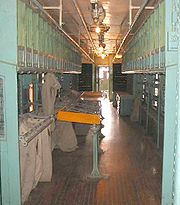
Combine

Baggage car
A baggage car or luggage van is a type of railway vehicle often forming part of the composition of passenger trains and used to carry passengers' checked baggage, as well as parcels . Being typically coupled at the front of the train behind the locomotive, this type of car is sometimes described...
, but the combination of coach and post office car
Railway post office
In the United States a railway post office, commonly abbreviated as RPO, was a railroad car that was normally operated in passenger service as a means to sort mail en route, in order to speed delivery. The RPO was staffed by highly trained Railway Mail Service postal clerks, and was off-limits to...
was also common. Combines were used most frequently on branch line
Branch line
A branch line is a secondary railway line which branches off a more important through route, usually a main line. A very short branch line may be called a spur line...
s and short line railroads where there wasn't necessarily enough traffic to economically justify single-purpose cars. As lightweight cars began to appear on railroads, passenger cars more frequently combined features of two or more car types on one car, and the classic heavyweight combine fell out of use.
Control car (Cab)
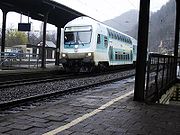
Dome car
A dome car can include features of a lounge car, dining car and an observation. A portion of the car, usually in the center of the car, is split between two levels, with stairs leading both up and down from the train's regular passenger car floor level. The lower level of the dome usually consisted of a small lounge area, while the upper portion was usually coach or lounge seating within a "bubble" of glass on the car's roof. Passengers in the upper portion of the dome were able to see in all directions from a vantage point above the train's roofline. On some dome cars, the lower portion was built as a galley, where car attendants used dumbwaiterDumbwaiter (elevator)
Dumbwaiters are small freight elevators intended to carry objects rather than people. Dumbwaiters found within modern structures, including both commercial and private buildings, are often connected between two floors...
s to transfer items between the galley and a dining area in the dome portion of the car.
Some dome cars were built with the dome extending the entire length of the car, while others had only a small observation bubble. There were also combination dome-observation cars built which were meant to be the last car on the train, with both rear observation and the dome up top.
Double-decker or Bilevel
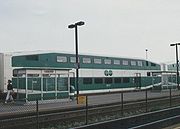
Amtrak
The National Railroad Passenger Corporation, doing business as Amtrak , is a government-owned corporation that was organized on May 1, 1971, to provide intercity passenger train service in the United States. "Amtrak" is a portmanteau of the words "America" and "track". It is headquartered at Union...
's Superliner
Superliner (railcar)
The Superliner is a double decker passenger car used by Amtrak on long haul trains that do not use the Northeast Corridor. The initial cars were built by Pullman-Standard in the late 1970s and a second order was built in the mid 1990s by Bombardier Transportation...
cars). Cars used on long-distance passenger trains could combine features of any of the basic car types, while cars used in local commuter service are often strictly coach types on both levels.
Double decker coaches were tried in the UK (SR Class 4DD
SR Class 4DD
Conceived by Oliver Bulleid for the Southern Railway's Dartford commuter route, the two 4DD electric multiple units were the only double-deck trains to run on the main line railway network in Britain. Whilst common in Europe and North America the restrictive railway loading gauge in the United...
) but the experiment was unsuccessful because the restricted British loading gauge
Loading gauge
A loading gauge defines the maximum height and width for railway vehicles and their loads to ensure safe passage through bridges, tunnels and other structures...
resulted in cramped conditions.
Private car

Amtrak
The National Railroad Passenger Corporation, doing business as Amtrak , is a government-owned corporation that was organized on May 1, 1971, to provide intercity passenger train service in the United States. "Amtrak" is a portmanteau of the words "America" and "track". It is headquartered at Union...
trains.
The only current example in Britain is the British Royal Train
British Royal Train
The Royal Train is a set of railway carriages dedicated for the use of the British Monarch, other members of the Royal Family, and their staff. The train enables members of the Royal Family to carry out busy schedules over an extended period, in a secure environment which minimises disruption and...
.
Drovers' car
Drovers' cars were used on long distance livestockLivestock
Livestock refers to one or more domesticated animals raised in an agricultural setting to produce commodities such as food, fiber and labor. The term "livestock" as used in this article does not include poultry or farmed fish; however the inclusion of these, especially poultry, within the meaning...
trains in the western United States. The purpose of a drovers' car was to accommodate the livestock's handlers on the journey between the ranch
Ranch
A ranch is an area of landscape, including various structures, given primarily to the practice of ranching, the practice of raising grazing livestock such as cattle or sheep for meat or wool. The word most often applies to livestock-raising operations in the western United States and Canada, though...
and processing plant. They were usually shorter, older cars, and equipped with stove heaters, as no trainline steam heating was provided.
Troop sleeper
A "troop sleeper" was a railroad passenger car which had been constructed to serve as something of a mobile barracks (essentially, a sleeping car) for transporting troops over distances sufficient to require overnight accommodations. This method allowed part of the trip to be made overnight, reducing the amount of transit time required and increasing travel efficiency. Troop kitchens, rolling galleys, also joined the consists in order to provide meal service en route (the troops took their meals in their seats or bunks). Troop hospital cars, also based on the troop sleeper carbody, transported wounded servicemen and typically travelled in solid strings on special trains averaging fifteen cars each.Hospital car
A variety of hospital trainHospital train
A hospital train is a railway train with carriages equipped for the provision of healthcare. Historically this has ranged from trains equipped to transport wounded soldiers, with basic nursing and first aid facilities on board, to fully equipped mobile medical centres, sometimes including operating...
s operate around the world, employing specialist carriages equipped as hospital wards, treatment rooms, and full-scale operating theatres.
Car technology
Passenger cars are as almost as old as railroading itself, and their development paralleled that of freight cars. Early two axle cars gave way to conventional two truck construction with the floor of the car riding above the wheels; link and pin couplers gave way to automatic types.Several construction details characterized passenger equipment. Passenger trains were expected to run at higher speeds than freight service, and therefore passenger trucks evolved to allow superior ride and better tracking at those speeds. Over time, in most cases provision was made for passengers and train staff to move from car to car; therefore platforms and later vestibules
Vestibuled train
A vestibuled train is a passenger train whose cars have enclosed vestibules at their ends, in contrast to the open platforms on early cars. Typically, a vestibule has doorways on either side to allow passenger egress at stations, a door into the body of the car, and, at the end of the car, a...
were used to bridge the gap.
In later years a number of changes to this basic form were introduced to allow for improvements in speed, comfort, and expense.
Articulated
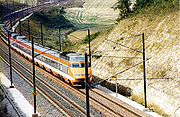
Articulated cars have a number of advantages. They save on the total number of wheels and trucks, reducing costs and maintenance expenses. Further, movement between cars is safer and easier than with traditional designs. Finally, it is possible to implement tilting schemes such as the Talgo
Talgo
Talgo is a Spanish manufacturer of railway vehicles. It is best known for a design of articulated railway passenger cars in which the wheels are mounted in pairs, but not joined by an axle, and being between rather than underneath the individual coaches...
design which allow the train to lean into curves. The chief disadvantage is that failure of a single car disables the entire set, since individual cars cannot be readily switched in and out of the consist.
Low-floor
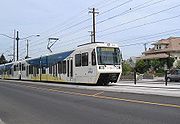
In some countries (such as the US), platform level may be below the level of the floor of passenger cars, resulting in a significant step up from platform level - leading to slower boarding times, which are important for high-capacity systems. Low-floor cars have their main passenger and loading floor directly on level with the loading platform, instead of having a step up to the passenger compartment as was traditional until around the 1970s. This is achieved by having a low-slung chassis with the "low floor" resting between the trucks, rather than resting completely on top with a simpler straight chassis design. This improved design is seen in many passenger cars today, especially double decker cars. The low floor enables easy access for bicycles, strollers, suitcases, wheelchairs and those with disabilities, which is otherwise not always convenient or even possible with the traditional passenger car design.
Self-propelled passenger equipment
These vehicles usually carry motive power in each individual unit. TramTram
A tram is a passenger rail vehicle which runs on tracks along public urban streets and also sometimes on separate rights of way. It may also run between cities and/or towns , and/or partially grade separated even in the cities...
s, Light Rail Vehicles and subways
Rapid transit
A rapid transit, underground, subway, elevated railway, metro or metropolitan railway system is an electric passenger railway in an urban area with a high capacity and frequency, and grade separation from other traffic. Rapid transit systems are typically located either in underground tunnels or on...
have been widely constructed in urban areas throughout the world since the late 19th century. By the year 1900, electric-powered passenger cars were ubiquitous in the developed world, but they fell into decline after World War II, especially in the U.S. By the year 2000 they had regained popularity and modern lines were being rebuilt where they had been torn up only 40 years earlier to make way for automobiles.
On lighter-trafficked rural railways, powered diesel cars
Railcar
A railcar, in British English and Australian English, is a self-propelled railway vehicle designed to transport passengers. The term "railcar" is usually used in reference to a train consisting of a single coach , with a driver's cab at one or both ends. Some railways, e.g., the Great Western...
(such as the Budd Rail Diesel Car
Budd Rail Diesel Car
The Budd Rail Diesel Car, RDC or Buddliner is a self-propelled diesel multiple unit railcar. In the period 1949–62, 398 RDCs were built by the Budd Company of Philadelphia, Pennsylvania, United States...
) continue to be popular. In Germany the new Talent
Talent (train)
The Talent is a multiple unit railcar manufactured by Bombardier that was developed by Waggonfabrik Talbot in Aachen shortly before the company was acquired by Bombardier in 1995...
design shows that the diesel-powered passenger car is still a viable part of rail service. In the UK, locomotive-hauled passenger trains have largely been replaced by diesel multiple unit
Diesel multiple unit
A diesel multiple unit or DMU is a multiple unit train consisting of multiple carriages powered by one or more on-board diesel engines. They may also be referred to as a railcar or railmotor, depending on country.-Design:...
s, such as the Bombardier Voyager family
Bombardier Voyager family
The Voyager series is a group of express diesel-electric multiple-unit trains built by Bombardier Transportation for service on the UK railway network.-Class 220:...
, even on express services.
Tilting
These cars are able to tilt to counter the effects of inertia when turning, making the ride more comfortable for the passengers. Amtrak has adopted TalgoTalgo
Talgo is a Spanish manufacturer of railway vehicles. It is best known for a design of articulated railway passenger cars in which the wheels are mounted in pairs, but not joined by an axle, and being between rather than underneath the individual coaches...
trainsets for its Amtrak Cascades
Amtrak Cascades
The Amtrak Cascades is a passenger train route operated by Amtrak in partnership with the states of Washington and Oregon in the Pacific Northwest of the United States and the province of British Columbia in Canada...
service in the Pacific Northwest. Other manufacturers have also implemented tilting designs. The British Rail Class 390
British Rail Class 390
The Class 390 Pendolino is a type of train used in Great Britain. They are electric multiple units using Fiat's tilting train pendolino technology and built by Alstom. Fifty-three 9-car units were originally built for Virgin Trains from 2001 to 2004 for operation on the West Coast Main Line , with...
is a tilting train operating in the UK.
Passenger car manufacturers
While some railroads, like the Milwaukee Road, preferred to build their own passenger cars, several railcar manufacturers built the majority of passenger cars in revenue service. Most of these companies produced both passenger and freight equipment for the railroads. This is by no means a comprehensive list of all passenger car builders (see List of rolling stock manufacturers for a more complete list). Quite a large number of firms built passenger cars over the years, but the majority of cars in the 20th century were built by these companies.American Car and Foundry
American Car and Foundry was formed in 1899 through the merger of 13 smaller railroad car manufacturing companies (in much the same way as the American Locomotive CompanyAmerican Locomotive Company
The American Locomotive Company, often shortened to ALCO or Alco , was a builder of railroad locomotives in the United States.-Early history:...
was formed from the merger of 8 smaller locomotive manufacturers two years later in 1901). ACF built the first all-steel
Steel
Steel is an alloy that consists mostly of iron and has a carbon content between 0.2% and 2.1% by weight, depending on the grade. Carbon is the most common alloying material for iron, but various other alloying elements are used, such as manganese, chromium, vanadium, and tungsten...
passenger car in the world for Interborough Rapid Transit in 1904, and then built the first steel cars used on the London Underground
London Underground
The London Underground is a rapid transit system serving a large part of Greater London and some parts of Buckinghamshire, Hertfordshire and Essex in England...
in the following year. The company continued to manufacture passenger equipment until 1959. ACF still manufactures freight cars today.
Bombardier
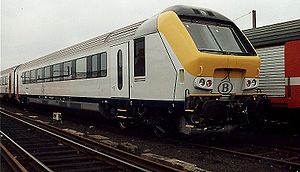
Bombardier Transportation
Bombardier Transportation is the rail equipment division of the Canadian firm, Bombardier Inc. Bombardier Transportation is one of the world's largest companies in the rail-equipment manufacturing and servicing industry. Its headquarters are in Berlin, Germany....
is the largest manufacturer of passenger cars in the world. This company started in Canada and has become multi-national, making everything from passenger cars to commuter aircraft in factories around the world.
Budd Company
The Budd CompanyBudd Company
The Budd Company is a metal fabricator and major supplier of body components to the automobile industry, and was formerly a manufacturer of stainless steel passenger rail cars during the 20th century....
got its start in the early 1930s when Edward G. Budd
Edward G. Budd
Edward Gowen Budd was an American inventor and businessman.Budd was born in Delaware in 1870. He studied engineering in Philadelphia in 1888, and in 1899 he took his knowledge of pressed steel to the railroad industry...
developed a way to build carbodies out of stainless steel. In 1932 he completed his first railcar, dubbed the Green Goose. It used rubber tires and a stainless steel body, and was powered by the engine out of Budd's own Chrysler Imperial
Chrysler Imperial
The Chrysler Imperial, introduced in 1926, was the company's top of the range vehicle for much of its history. Models were produced with the Chrysler name until 1954, and again from 1990 to 1993. The company tried to position the cars as a prestige marque that would rival Cadillac and Lincoln...
automobile. Budd sold a few of these early powered cars to the Reading Railroad, Pennsylvania Railroad
Pennsylvania Railroad
The Pennsylvania Railroad was an American Class I railroad, founded in 1846. Commonly referred to as the "Pennsy", the PRR was headquartered in Philadelphia, Pennsylvania....
and the Texas and Pacific Railway
Texas and Pacific Railway
The Texas and Pacific Railway Company was created by federal charter in 1871 with the purpose of building a southern transcontinental railroad between Marshall, Texas, and San Diego, California....
. The next year, Ralph Budd
Ralph Budd
Ralph Budd was an American railroad executive.-Early life:One of six children of John and Mary Budd, Ralph was born on a farm near Waterloo, Iowa on August 20, 1879...
, only a very distant relation, but president of the Chicago, Burlington and Quincy Railroad
Chicago, Burlington and Quincy Railroad
The Chicago, Burlington and Quincy Railroad was a railroad that operated in the Midwestern United States. Commonly referred to as the Burlington or as the Q, the Burlington Route served a large area, including extensive trackage in the states of Colorado, Illinois, Iowa, Kentucky, Missouri,...
at the time, came to Budd to build the Pioneer Zephyr
Pioneer Zephyr
The Pioneer Zephyr is a diesel-powered railroad train formed of railroad cars permanently articulated together with Jacobs bogies, built by the Budd Company in 1934 for the Chicago, Burlington and Quincy Railroad , commonly known as the Burlington...
.
Budd was soon called on by another railroad president before the end of the decade. Samuel T. Bledsoe
Samuel T. Bledsoe
Samuel T. Bledsoe was the sixteenth president of Atchison, Topeka and Santa Fe Railway.- Early life and family :...
asked Budd to build the new lightweight cars for the Santa Fe
Atchison, Topeka and Santa Fe Railway
The Atchison, Topeka and Santa Fe Railway , often abbreviated as Santa Fe, was one of the larger railroads in the United States. The company was first chartered in February 1859...
's new Super Chief
Super Chief
The Super Chief was one of the named passenger trains and the flagship of the Atchison, Topeka and Santa Fe Railway. It was often referred to as "The Train of the Stars" because of the many celebrities who traveled on the streamliner between Chicago, Illinois and Los Angeles, California.The Super...
passenger train.
Budd continued building lightweight powered and unpowered cars through the 20th century for nearly every major railroad in North America.
Kawasaki
Kawasaki has been manufacturing passenger rail cars at its facility in Lincoln, Nebraska since 2001. Kawasaki's Lincoln plant has manufactured rail cars for MBTA, NYCT, PATH, MNR with cars that have lead the way with the industry's best MTBF (Mean Time Between Failures). Kawasaki Rail Car was the first American rail car manufacturer to achieve the International Standard Organization ISO-9002 certification.Pullman
The most famous of all the car manufacturers was Pullman, which began as the Pullman Palace Car Company founded by George PullmanGeorge Pullman
George Mortimer Pullman was an American inventor and industrialist. He is known as the inventor of the Pullman sleeping car, and for violently suppressing striking workers in the company town he created, Pullman .-Background:Born in Brocton, New York, his family moved to Albion,...
in 1867. The Pullman Palace Car Company manufactured railroad cars in the mid-to-late 19th century through the early decades of the 20th century during the boom of railroads in the United States.
Pullman developed the sleeping car which carried his name into the 1980s.
In 1900, the Pullman Palace Car Company was reorganized as The Pullman Co..
In 1924, Pullman Car & Manufacturing Co. was organized from the previous Pullman manufacturing department to consolidate the car building interests of The Pullman Co.
In 1934, Pullman Car & Manufacturing merged with Standard Steel Car Co. to form the Pullman-Standard Car Manufacturing Company, which remained in the car manufacturing business until 1982. Pullman manufactured its last cars for Amtrak in 1981. The last car built and delivered at the end of July 1981 was named George Mortimer Pullman in honor of the company's founder.
Siemens AG
The Siemens was founded in 1847 in BerlinBerlin
Berlin is the capital city of Germany and is one of the 16 states of Germany. With a population of 3.45 million people, Berlin is Germany's largest city. It is the second most populous city proper and the seventh most populous urban area in the European Union...
, Germany
Germany
Germany , officially the Federal Republic of Germany , is a federal parliamentary republic in Europe. The country consists of 16 states while the capital and largest city is Berlin. Germany covers an area of 357,021 km2 and has a largely temperate seasonal climate...
building Conglomerates, Electric and Industry products, Healthcare Radioative systems, rolling stock,etc. The Siemens "Viaggio" passenger car models are to all purposes in the European railways: Viaggio Twin: double-deck coaches used on CityNightLine
CityNightLine
CityNightLine AG was a Swiss night train service. CNL had right of passage grants in Germany, the Netherlands, Austria, Switzerland and Denmark. It served stations in Belgium, France, Italy and the Czech Republic...
and ÖBB
ÖBB
The Austrian Federal Railways is the national railway system of Austria, and the administrators of Liechtenstein's railways...
CityShuttle regional trains; Viaggio Classic: Original Siemens passenger cars, similar to Eurofima UIC cars
Eurofima coach
The Eurofima coach, or European Standard Coach , is a passenger car designed for use on international railway routes in Europe. It was commissioned by the European Company for the Financing of Railroad Rolling Stock ....
, used in Germany
Germany
Germany , officially the Federal Republic of Germany , is a federal parliamentary republic in Europe. The country consists of 16 states while the capital and largest city is Berlin. Germany covers an area of 357,021 km2 and has a largely temperate seasonal climate...
, Greece
Greece
Greece , officially the Hellenic Republic , and historically Hellas or the Republic of Greece in English, is a country in southeastern Europe....
, Czech Republic
Czech Republic
The Czech Republic is a landlocked country in Central Europe. The country is bordered by Poland to the northeast, Slovakia to the east, Austria to the south, and Germany to the west and northwest....
and Austria
Austria
Austria , officially the Republic of Austria , is a landlocked country of roughly 8.4 million people in Central Europe. It is bordered by the Czech Republic and Germany to the north, Slovakia and Hungary to the east, Slovenia and Italy to the south, and Switzerland and Liechtenstein to the...
; Viaggio Light
Siemens Viaggio Light
Siemens Viaggio Light is a standard gauge single-deck passenger train made by Siemens AG, initially as the diesel ISR SDPP Train for Israel Railways. The first order included 87 cars, with an option for a total of 585 cars. The cars arrived in Israel during 2008 and are gradually entering service...
: new low-floor regional passenger coaches now used in Israel
Israel
The State of Israel is a parliamentary republic located in the Middle East, along the eastern shore of the Mediterranean Sea...
and Viaggio Comfort: New luxury articulated coaches used on ÖBB
ÖBB
The Austrian Federal Railways is the national railway system of Austria, and the administrators of Liechtenstein's railways...
's railjet
Railjet
The Railjet is a high speed train of the Austrian Federal Railways , which was introduced with the timetable change of 2008–2009 and operates at speeds of up to , with a planned increase to by 2013...
and Siemens Coach 2000 prototype lounge car.
St. Louis Car Company
Founded in April 1887, in its namesake city, St. Louis Car CompanySt. Louis Car Company
The St. Louis Car Company was a major United States manufacturer of railroad passenger cars, streetcars, trolleybuses and locomotives that existed from 1887–1973, based in St. Louis, Missouri.-History:...
manufactured railroad cars for streetcar lines (urban passenger railways) and steam railroads. The company made brief forays into building automobile
Automobile
An automobile, autocar, motor car or car is a wheeled motor vehicle used for transporting passengers, which also carries its own engine or motor...
s and aircraft
St. Louis Aircraft Corporation
St. Louis Aircraft Corporation was a American aircraft manufacturer founded in September 1917.In 1915, the St. Louis Car Company had been approached by Thomas W. Benoist to build 1000 flying boats in 1915. A prototype was built, but the concept did not into production.In 1917 The United States...
, but they are best known as the manufacturers of Birney
Birney
A Birney or Birney Safety Car is a type of streetcar that was manufactured in the United States in the 1910s and 1920s. The design was small and light and was intended to be an economical means of providing frequent service at a lower infrastructure and labor cost than conventional streetcars...
and PCC
PCC streetcar
The PCC streetcar design was first built in the United States in the 1930s. The design proved successful in its native country, and after World War II was licensed for use elsewhere in the world...
streetcars which have seen worldwide use. St. Louis Car Company closed in 1973.
Lighting, heating, air-conditioning
The earliest form of train lighting was provided by Colza oilColza oil
Colza oil is a nondrying oil obtained from the seeds of Brassica rapa, var. oleifera, a variety of the plant that produces turnips. Colza is extensively cultivated in France, Belgium, the United States, the Netherlands and Germany and Poland. In France, especially, the extraction of the oil is an...
lamps. The next stage was gas lighting
Gas lighting
Gas lighting is production of artificial light from combustion of a gaseous fuel, including hydrogen, methane, carbon monoxide, propane, butane, acetylene, ethylene, or natural gas. Before electricity became sufficiently widespread and economical to allow for general public use, gas was the most...
, using compressed gas stored in cylinders under the coaches. Finally, electric lighting was introduced.
Early railway coaches had no heating but passengers could hire foot-warmers. These worked on the same principle a modern sodium acetate
Sodium acetate
Sodium acetate, CH3COONa, also abbreviated NaOAc, also sodium ethanoate, is the sodium salt of acetic acid. This colourless salt has a wide range of uses.-Industrial:...
heating pad
Heating pad
A heating pad is a pad used for warming of parts of the body in order to manage pain. Localized application of heat causes the blood vessels in that area to dilate, enhancing perfusion to the targeted tissue...
s. Later, steam heating was introduced, using a steam supply from the steam locomotive
Steam locomotive
A steam locomotive is a railway locomotive that produces its power through a steam engine. These locomotives are fueled by burning some combustible material, usually coal, wood or oil, to produce steam in a boiler, which drives the steam engine...
. Steam heating continued into the diesel locomotive
Diesel locomotive
A diesel locomotive is a type of railroad locomotive in which the prime mover is a diesel engine, a reciprocating engine operating on the Diesel cycle as invented by Dr. Rudolf Diesel...
era, with steam supplied by a steam generator
Steam generator (railroad)
Steam generator is the term used to describe a type of boiler used to produce steam for climate control and potable water heating in railroad passenger cars...
. Now, electric heating
Electric heating
Electric heating is any process in which electrical energy is converted to heat. Common applications include space heating, cooking, water heating and industrial processes. An electric heater is an electrical appliance that converts electrical energy into heat...
is almost universal and air-conditioning is often provided as well. In the case of diesel multiple unit
Diesel multiple unit
A diesel multiple unit or DMU is a multiple unit train consisting of multiple carriages powered by one or more on-board diesel engines. They may also be referred to as a railcar or railmotor, depending on country.-Design:...
s, the coaches may be heated by waste heat from the engines, as in an automobile
Automobile
An automobile, autocar, motor car or car is a wheeled motor vehicle used for transporting passengers, which also carries its own engine or motor...
.
See also
- Private railroad carPrivate railroad carA private railroad car, private railway coach, private car or private varnish is a railroad passenger car which was either originally built or later converted for service as a business car for private individuals. A private car could be added to the make-up of a train or pulled by a private...
- List of named passenger trains - where the cars were used
- :Category:Named passenger trains
- Train stationTrain stationA train station, also called a railroad station or railway station and often shortened to just station,"Station" is commonly understood to mean "train station" unless otherwise qualified. This is evident from dictionary entries e.g...
- The public interface to passenger trains around the world - Travel classTravel classA travel class is a quality of accommodation on public transport. The accommodation could be a seat or a cabin for example. Higher travel classes are more comfortable and more expensive.-Airline booking codes:...
- First class travelFirst class travelFirst class is the most luxurious class of accommodation on a train, passenger ship, airplane, or other conveyance. It is usually much more expensive than business class and economy class, and offers the best amenities.-Aviation:...
Technologies used
- Railway brakesBrake (railway)Brakes are used on the cars of railway trains to enable deceleration, control acceleration or to keep them standing when parked. While the basic principle is familiar from road vehicle usage, operational features are more complex because of the need to control multiple linked carriages and to be...
- Air brakeAir brake (rail)An air brake is a conveyance braking system actuated by compressed air. Modern trains rely upon a fail-safe air brake system that is based upon a design patented by George Westinghouse on March 5, 1872. The Westinghouse Air Brake Company was subsequently organized to manufacture and sell...
- Vacuum brakeVacuum brakeThe vacuum brake is a braking system employed on trains and introduced in the mid-1860s. A variant, the automatic vacuum brake system, became almost universal in British train equipment and in those countries influenced by British practice. Vacuum brakes also enjoyed a brief period of adoption in...
- Passenger train toiletsPassenger train toiletsIn rail transport, many passenger trains have toilet facilities on board. These are often located at the ends of carriages...
- Low-floor trains
- Double decker train - Many commuter coaches were built as bilevel cars, such cars still operate in many large cities in North America.
External links
- PRR Equipment Diagrams (includes detailed floorplans of all types of passenger cars by various builders used on the Pennsylvania Railroad, as well as freight cars and locomotives)
- St. Louis Car Company Collection at Washington University, St. Louis
- Flexible Railway Passenger Cars - a study on more efficient use of passenger equipment
- The Abraham Lincoln 1910 Heavyweight Pullman Business Car
- The American Association of Private Railroad Car Owners, Inc. - information on owning and chartering private railroad cars
- List of railroad car manufacturers by country (in FrenchFrench languageFrench is a Romance language spoken as a first language in France, the Romandy region in Switzerland, Wallonia and Brussels in Belgium, Monaco, the regions of Quebec and Acadia in Canada, and by various communities elsewhere. Second-language speakers of French are distributed throughout many parts...
)

